Cell Division
Cell division 是指細胞分裂的過程,是生物體繁殖的基礎。它是一個循環性的步驟,細胞會先進行 DNA 複製,接著細胞質會分裂,最後細胞會分裂出兩個新的細胞,完成 cell division 的過程。
Cell division 可以分為 mitosis 和 meiosis 兩種。 Mitosis 是一種簡單的細胞分裂,是由一個細胞分裂出兩個細胞的過程,此分裂會將細胞的 DNA 複製一份,然後將它們分給兩個新的細胞。 Meiosis 則是一種更為複雜的細胞分裂,目的是產生出性細胞 (例如精子和卵子),此分裂會將一個細胞分裂成四個細胞,並且將複製的 DNA 分給四個新的細胞。
Introduction to cell division
人類有 23 對 chromosomes,其中 23 個來自父親,另外 23 個來自母親。 帶有 23 對 chromosomes 的細胞不斷複製,變成我們現在這樣。
Fertilization terminology
首先我們先介紹一下關於 fertilization 相關的術語
- Gametes (配子)
- Sperm (精子) 或 Ovum (卵子)
- 在人類有 23 個 chromosomes (染色體)
- 最後一個 chromosome 決定性別
- 父親的 sperm 有 X, Y
- 母親的 ovum 只有 X
- XX 是女生,XY 是男生
- Zygotes (受精卵)
- 組合父母的 sperm 和 ovum 形成
- 共有 23 對 homologous chromosomes (46 個)
- Homologous 意思是該對 chromosomes 負責 code 相同的特徵 (例如頭髮顏色)
- 從這邊開始可以不斷複製,形成我們現在的樣子
因為生物都會有 fertilization 的現象,所以 biologist 給予上面兩個名詞一個統整
- Haploid (單倍體)
- 例如人類的 gametes
- Gametes 的 haploid number 為 23
- Diploid (二倍體)
- 例如人類的 zygotes
- Zygotes 的 diploid number 為 46
生物界通常會用 n 代表 haploid number,用 2n 代表 diploid number
DNA and genomes
細胞分裂時,需要完整將 genetic material 的 copy 分給兩個小孩,否則將會造成 disease 甚至 cancer
- DNA (deoxyribonucleic acid) 就是 genetic material
- 當細胞要分裂時,會將 DNA copy 分給他的兩個新細胞
- DNA 也會在 sperm 和 egg cells 結合時,作為父母的 genetic material 傳給小孩
- DNA 是一長串由 paired nucleotides 所組成的東西
- Nucleotides 主要分為 A, T, C, G 四類
- Paired nucleotides 會記錄一些資訊,我們將他序列化叫做 genes
- Genes 會提供製造 protein 的指令,讓細胞能夠正常運作
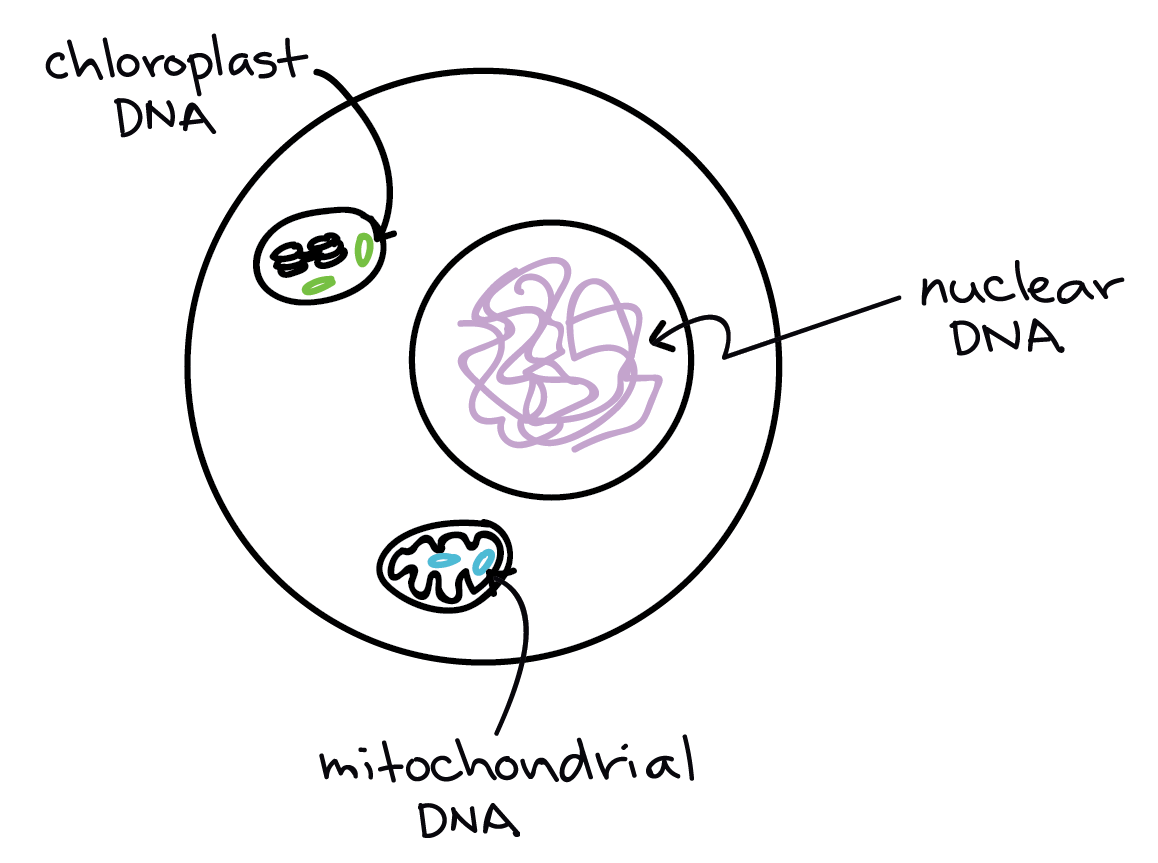
- 動物和植物的主要 DNA 都位在細胞的 nucleus 稱作 nuclear DNA
- Mitochondria (發電站) 也有自己的 mitochondrial DNA
- 植物中負責進行 photosynthesis 的 chloroplast 也有 chloroplast DNA
- mitochondrial DNA 和 chloroplast DNA 皆小於 nuclear DNA
- 而 bacteria 的 DNA 位於 nucleoid,跟 eukaryotes 的 nuclear DNA 功用類似
一個細胞的一整組 DNA set 稱做 genome
- 通常一個生物體包含相同的 DNA
- 所以可以說該生物體有自己的 genome
- 又或者類似物種都有相似的 genomes
- 所以可以說 genome of species
- 當你聽到 human genome 指的就是在 nucleus 中的 set of DNA
- Mitochondria 和 chloroplasts 都有自己的 genomes
Chromatin
- DNA 通常無法自己獨立存在,需要有特別的 proteins 來支撐他
- 在 eukaryotes 通常為 histones
- Histones 是 positively charged proteins
- 形成類似 bobbins (線筒) 來讓 negatively charged DNA 纏繞
- Histones 還決定了哪一段的 genes 應被 active
複雜的 DNA 和 histones 和其他 structural proteins 組合成 chromatin (染色質)

- Chromatin 的形狀為 decondensed
- 顯微鏡底下是又細又長的形狀
- 為了是要讓 DNA 能夠良好的被使用
- 例如讓 protein 來 read, copy DNA
- 這對細胞的生長和運作非常重要
為什麼要用 decondensed 而不要用 stringy ?
- 因為 chromatin 其實可以轉為 condense 的
- Chromatin 會在細胞分裂時壓縮
- 此時會形成一個個的 linear pieces 稱做 chromosomes
Chromosomes
- 每種物種都有不一樣數量的 chromosomes
- 人類的 somatic cell 有 46 個
- 狗狗的 somatic cell 有 78 個
- 通常 animals 和 plants 都是 diploid (2n)
- 代表 chromosomes 都是一對對配對好的 homologous pairs
- 可以說某一邊的 chromosome 對於另一邊是 homologues
- 人類的 sperm 和 eggs 只有上面 pair 中的 1 個 homologous chromosome
- 可以說是 haploid (1n)
- 所以你的 genome 中的 chromosomes (homologous pairs) 是來自父母各自的 haploid
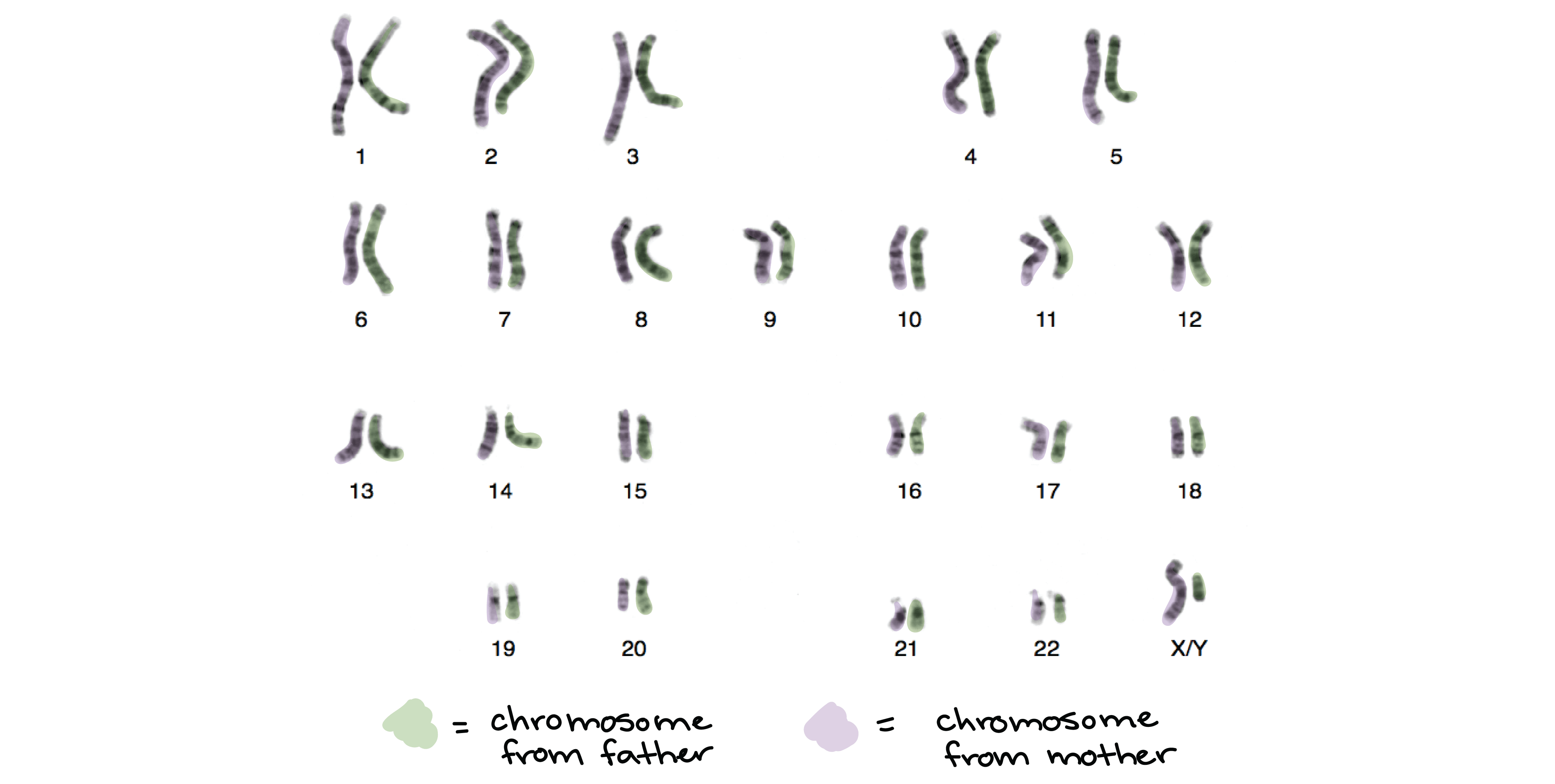
可以看到每個 homologous pair 中的 2 個 chromosomes 都非常相似
- 因為兩者皆攜帶著相同類型的 genetic information
- 就是 "Same genes in the same location"
- 但不用是完全一樣的 gene version (從遺傳可以看到)
- 例如 chromosome 9 定義了 blood type
- 有可能父母都是 type A
- 有可能父母分別是 type A 和 type B (讓你成為 type AB)
- 例如 chromosome 9 定義了 blood type
最後一對 chromosomes 有些不同,是 sex chromosomes (X, Y)
- 這對 chromosomes 不是 homologues (是例外)
- 代表在相同位置不為相同的 genes
- 只有小部分為了 meiosis 或 sex cell production 才會一樣
- 另外除了 sex chromosomes 以外的 44 個稱做 autosomes
Chromosomes and cell division

在細胞準備分裂之前,需要先將所有 chromosomes 都複製一遍
- 複製出來的兩個 chromosomes 叫做 sister chromatids
- 兩個是完全一樣的
- 兩個透過 cohesins (protein) 吸附在一起
- 最緊密的連接處叫做 centromere (chromosome X 形狀中間那點)
- Centromere 對待會的分裂非常重要
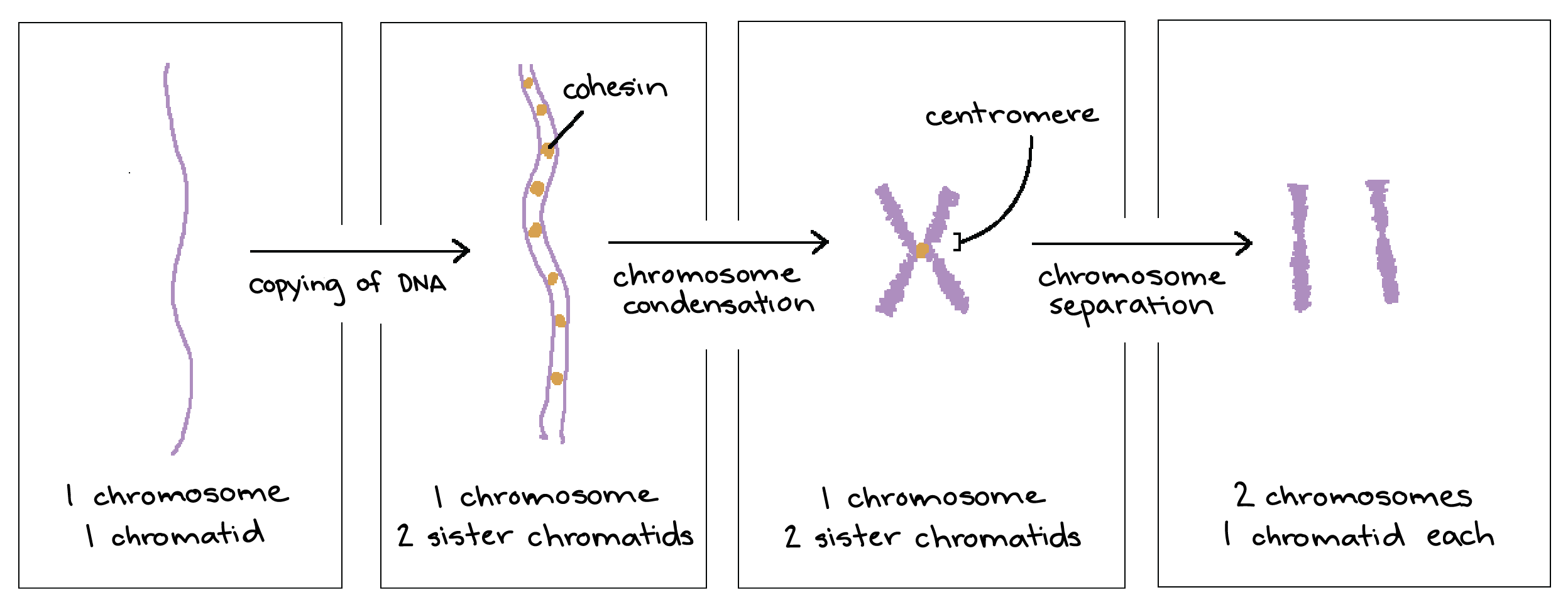
- 連接在一起的 2 個 chromatids 可以視為 1 個 chromosome
- 分開後就變成 2 個 chromosomes
為什麼簡單的分裂要多了 DNA replication, condensation, separation ?
- 這是為了確保每個新細胞中的 chromosomes 都被正確 copy
- 更深入的部分要講到 mitosis
The cell cycle and mitosis
細胞的生命週期 (cell cycle) 主要講述該細胞從 birth (division of mother cell) 到 reproduction (division to make two daughter cells)
- 在細胞執行分裂之前,需要先複製 genetic material (DNA)
- 過程是非常有順序的一個 cycle
- 因為 daughter cells 可以完整重新執行一次,所以是 cycle
- 在 eukaryotic cells 中會將 cycle 分成兩大階段
- Interphase
- 細胞成長並複製自己的 DNA
- Mitotic (M) phase
- 複製好的 DNA 分成兩份,cytoplasm 也分成兩份,形成兩個新細胞
- Interphase
- 過程是非常有順序的一個 cycle
Interphase
從 mother cell 分裂出來的細胞,接下來要做哪些事才能分裂自己呢 ?
- 在分裂前的階段稱為 Interphase
- inter- 指的是 between,意思是兩次 mitotic phase 的中間
- 主要又可分成 3 階段
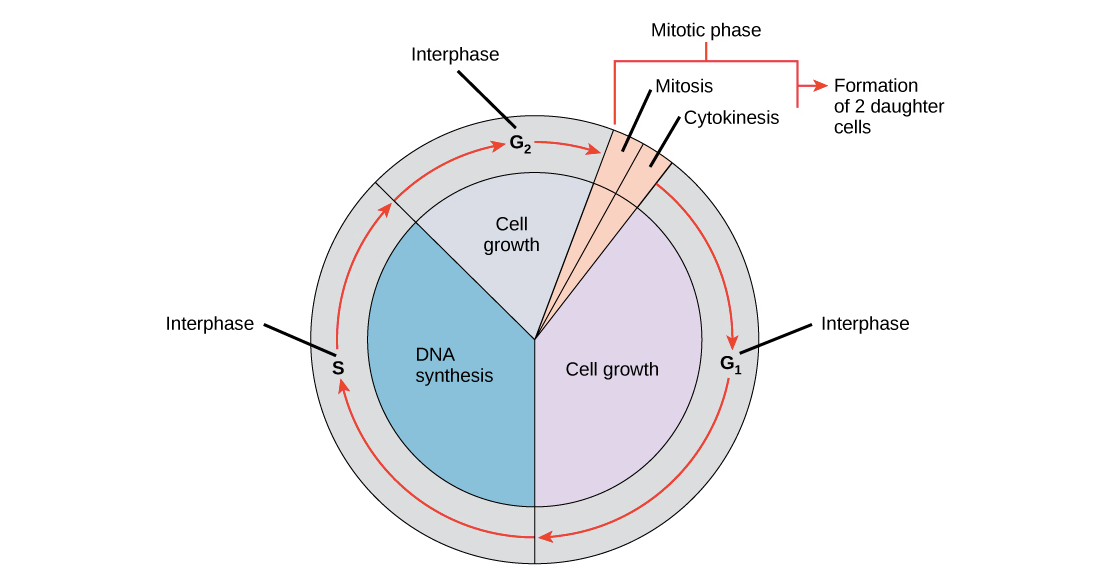
- G1 phase
- 細胞成長變大
- 複製一些 organelles
- 建立一些待會會用到的 building blocks
- S phase
- 在 nucleus 中合成完整的 DNA copy
- 同時複製一個 centrosome (microtubule-organizing structure)
- Centrosome 未來用於分離 DNA
- G2 phase
- 細胞進一步成長變大
- 一樣製造一些 proteins, organelles
- 將內容物重新整理準備進行 mitosis
Mitotic (M) phase
Mitotic phase 正式要將細胞拆成 2 個新細胞 (各自有新的 DNA 和 cytoplasm)
- Mitotic phase 可以分成兩個工作
- Mitosis
- Nuclear DNA 會被 condnese 變成看的到的 chromosomes
- 接著被 mitotic spindle (from centrosome) 扯開變成兩半
- Mitosis 又可以細分成四大步驟
- Prophase (early prophase + prometaphase)
- Metaphase
- Anaphase
- Telophase
- Cytokinesis
- 細胞的 cytoplasm 被拆開為二
- 正式變成兩個獨立的細胞
- 動物跟植物的 cytokinesis 有些不同
- 動物由 contractile ring 收縮分裂
- 植物由 cell plate 來分割
- Mitosis
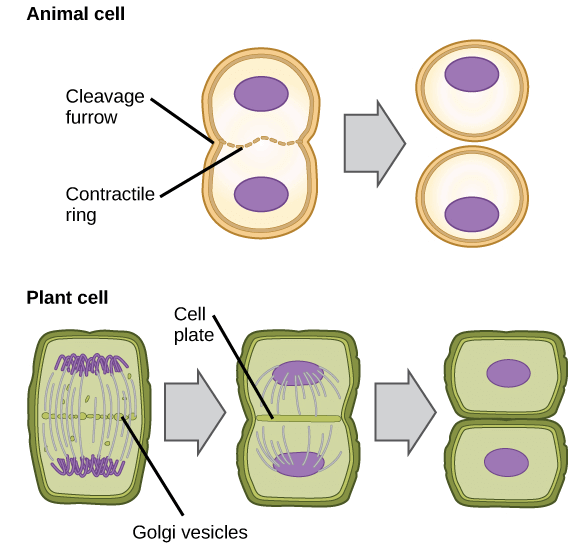
G0
- 細胞分裂的快慢因細胞而異
- 像 embryo 或 tumor 中的細胞就分裂複製非常的快速
- 但有的細胞幾乎不會分裂、甚至根本不分裂
- 他們會由 G1 phase 進入休息狀態 G0 phase
- 只進行他們原本該做的工作
- 例如 conduct signals, store carbohydrates
- 等到特定 signal 再重新開始分裂
Cell cycle time
- Cell cycle 一樣會依細胞而異
- 一般細胞通常需要 24 hours
- Intestine 中的細胞可以用 9-10 hours 就完成一次 cycle
- 有的更是會改變 cycle 的過程
- 例如青蛙的 embryos 細胞
- 會快速通過 G1 和 G2,只對 zygotes 進行 S 和 M phase
- 讓一個細胞分裂成多個小細胞
Phase of mitosis
- Mitosis 在 division 的工作是給予兩個分裂細胞一模一樣的 chromosomes
- 目標是讓兩個新細胞能有完整、正確的 chromosomes
- 太少或太多 chromosomes 都可能造成嚴重後果 (not survive, cause cancer)
- 所以 mitosis 有一系列良好的步驟來複製 chromosomes

- 上面就是完整的 mitosis 進行步驟
- Prophase 有時會被分為 early phase (prophase) 和 late phase (prometaphase)
- Cytokinesis 會在 anaphase 的階段就開始同時進行
Late G2
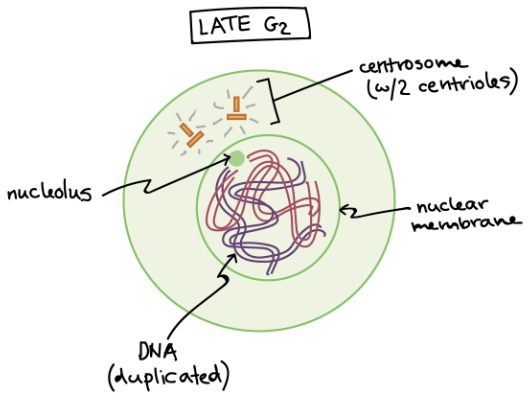
- Interphase 的最後一步 G2 過後
- 細胞已經複製好 DNA
- 每個 chromosomes 都有對應的 copy (兩者稱作 sister chromatids)
- 動物細胞會順便複製 centrosome
- 會在待會的 mitosis 扮演重要角色
- 植物有另外的 microtubule organizing center 取代 centrosomes
- 細胞已經複製好 DNA
Early prophase
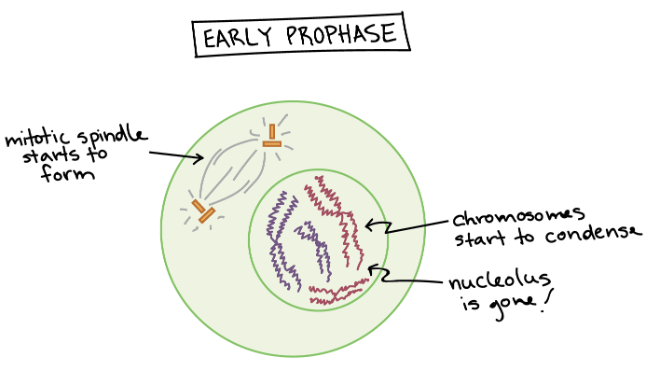
- Chromosomes 開始進行 condense (方便待會被拉開)
- Mitotic spindle 開始形成
- 主架構是 strong fibers (細胞的 skeleton) 形成的 microtubules
- 負責在待會移動 chromosomes
- spindle 在 2 個 centrosomes 分開的過程中形成
- Nucleolus 消失不見
- 示意 nucleus 準備好被分解
Late prophase (prometaphase)
在這個階段 mitotic spindle 開始去抓取並移動 chromosomes
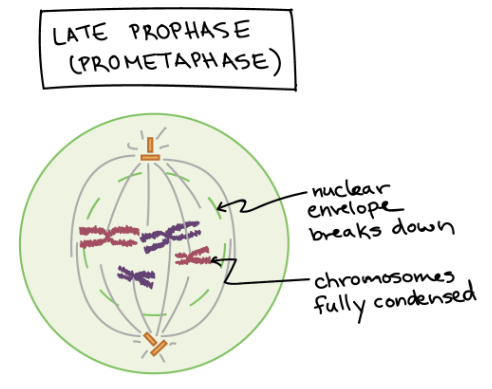
- Chromosomes 完成了 condensation 變得非常 compact
- Nuclear envelope 也被完全分解,將 chromosomes 釋放出來
- Mitotic spindle 長了更多,開始 "capture" 這些 chromosomes
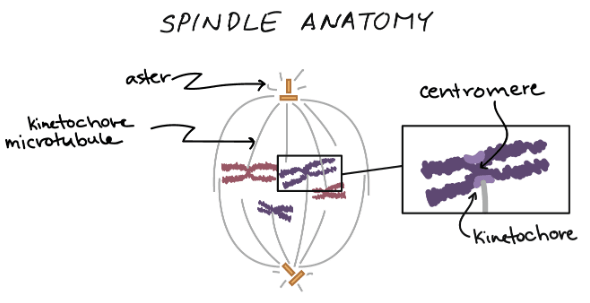
- Microtubules 會與 chromosomes 結合
- 結合點在 centromere 的 kinetochore
- 這些和 kinetochore 結合的叫做 kinetochore microtubules
- 其他的 microtubules 會繼續長在細胞內維持穩定性,形成 aster 的架構
Metaphase
Mitotic spindle 已經抓好所有的 chromosomes 並且將他們置中
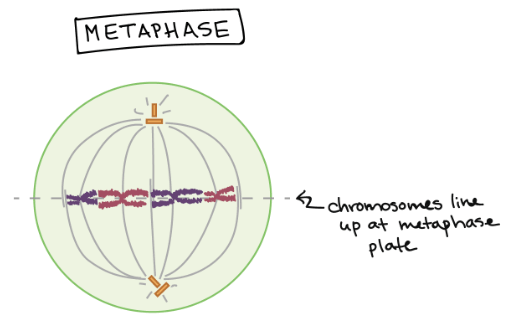
- 所有 chromosomes 排列整齊
- 形成類似 metaphase plate 的樣子
- 每個 chromosome (sister chromatids) 的 2 個 kinetochores
- 應該都要跟對應的 microtubules 結合
- 確認每個 chromosomes 的 kinetochores 都有良好地附在正確的 microtubules
- 這個確認叫做 spindle checkpoint
- 若錯誤就暫停分裂,直到問題解決
Anaphase
Sister chromatids 被拉開到細胞的兩邊了 !
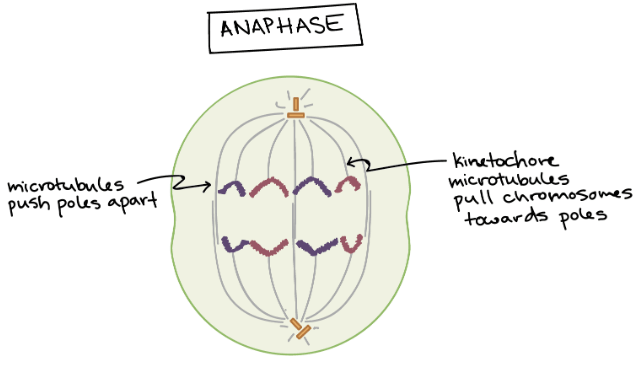
- 幫助黏住 sister chromatids 的 protein 被分解
- 現在 2 個 chromatids 個別都是獨立的 chromosomes
- Microtubules 開始加長
- 整個細胞被拉得更長
- 這些工作都是由 motor proteins 在驅動
- Motor proteins 可以走在 microtubules 中運送貨物 (chromosomes, other microtubules)
Telophase
分裂就快完成了 ! 開始重建一個細胞該有的內容物
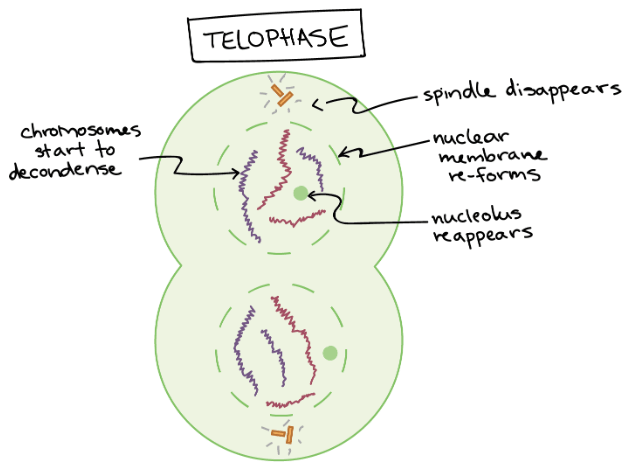
- Mitotic spindle 消失,分解回原來的 building blocks 之中
- 2 個 nuclei 重建,每個有自己的 chromosome set
- Nuclear membrane 和 nucleolus 也現身
- Chromosomes 開始 decondense 變回 stringy 的形狀
Cytokinesis

- Cytokinesis 階段會將細胞的 cytoplasm 拆成兩半
- 可能從 anaphase 開始,可能從 telophase 開始
- 但會在 telophase 之後結束
- 最終就會產生兩個完全跟 mother cell 一樣的細胞
- 有著一樣且完整的 chromosome set
Meiosis
Mitosis 的目的是 development 和 replace 壞掉的細胞,而 meiosis 則是致力於生產 gametes (sex cells)
- Meiosis 的目標是製造 4 個 cells
- 每個都有剛好一半的 chromosome 數量
- 例如人類 46 個,就要製造出 23 個的細胞
- 換句話說,Meiosis 要將原本的 diploid cell (兩組 chromosomes 從爸媽而來)
- 變成 haploid cells (單組 chromosomes)
- 對人類來說就是 sperm & eggs
- Sperm 和 eggs 結合會產生完整的 diploid set (而且是新的 genome)
- 每個都有剛好一半的 chromosome 數量
Phases of meiosis
Meiosis 的過程很多地方都跟 mitosis 策略差不多
- 不同點
- Mitosis 只有分裂複製好的 sister chromatids
- Meiosis 分裂 sister chromatids 和 homologous chromosomes
- Sister chromatids 是把 somatic cell 複製成兩份 chromosome
- Homologous chromosomes 則是由父母各給一半的 chromosome pairs
所以 meiosis 可以分成兩階段的 division process
- Meiosis I
- 先拆掉 homologue pairs
- 有 prophase I, metaphase I, anaphase I, telophase I
- Meiosis II
- 再拆掉 sister chromatids
- 有 prophase II, metaphase II, anaphase II, telophase II
因為有 2 次分裂,共產生 4 個 gametes (eggs or sperm)
Meiosis I
在進入 meiosis 前,一樣要先完成 interphase (G1, S, G2) 階段,複製好 chromosomes
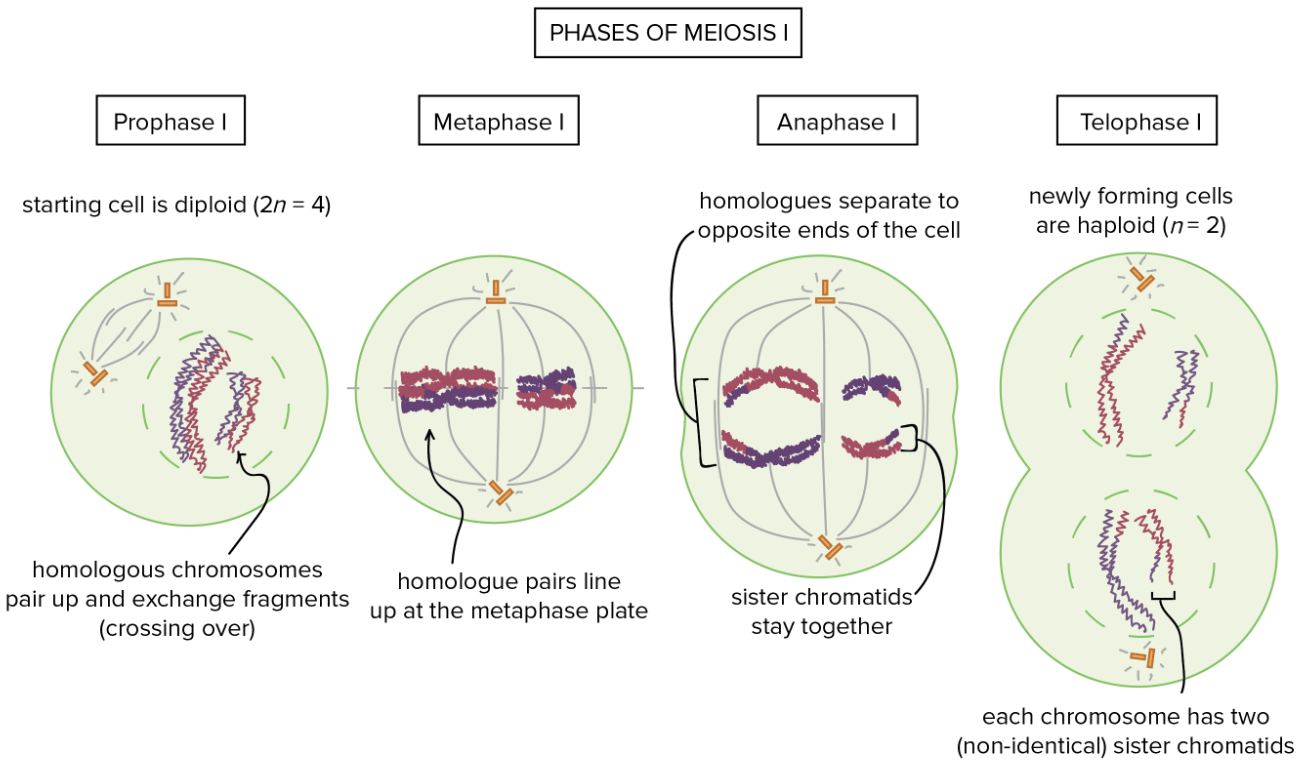
Prophase I
- Chromosomes 像 mitosis 一樣 condense
- 但不同的是,他們順便配對在一起
- 每個 chromosome 都和 homologue partner 排列在一起
- 但不同的是,他們順便配對在一起
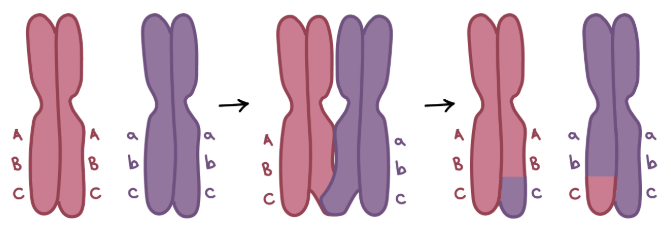
以上圖來說,ABC 和 abc (大小寫) 分別代表父母同段的 genes (alleles)
- 這時 B, C 這段會互相和 homologues 交換 DNA
- 這個交易的行程稱作 crossing over
- 事實上父母的 chromosomes 會由 synaptonemal complex 幫忙黏在一起
- 某一方的 chromosome 會疊在上面 (而不是像上圖一樣在隔壁)
Metaphase I
- 跟 mitosis 一樣,再來 spindle 會將 chromosomes 移到中央 (metaphase plate)
- 不一樣的是,每個 homologue pairs 包含複製,會被 microtubules 拉到相同的位置
- 並且 pairs 會是隨機的方向
- 為了讓 gametes 有不同的可能性
- 例如上圖中粉色大和紫色小朝向上方,但也有可能發生粉色大和粉色小同時朝向上方
Anaphase I
- Homologues pairs 被拉到細胞的兩端
- 但是 sister chromatids 依然沒有被分離
Telophase I
- Chromosomes 分別來到兩端
- Nuclear membrane 重新出現
- Chromosomes decondense
- 有的生物會將這步跳過,因為細胞馬上就要再進行下一輪分裂 (meiosis II) 了
- Cytokinesis 會在此階段同時開始,試著將細胞分成兩個 haploid cells
Meiosis II
Meiosis I 產生的兩個細胞沒有繼續複製 DNA 就進入到 meiosis II
- Meiosis II 比 meiosis I 的 process 還要更短更簡單
- 可以視為 mitosis 的 haploid 版本
從下圖可以看到,一開始每個細胞剩下兩個 chromosomes (每個來自父母其中一邊,但是是 sister chromatids)
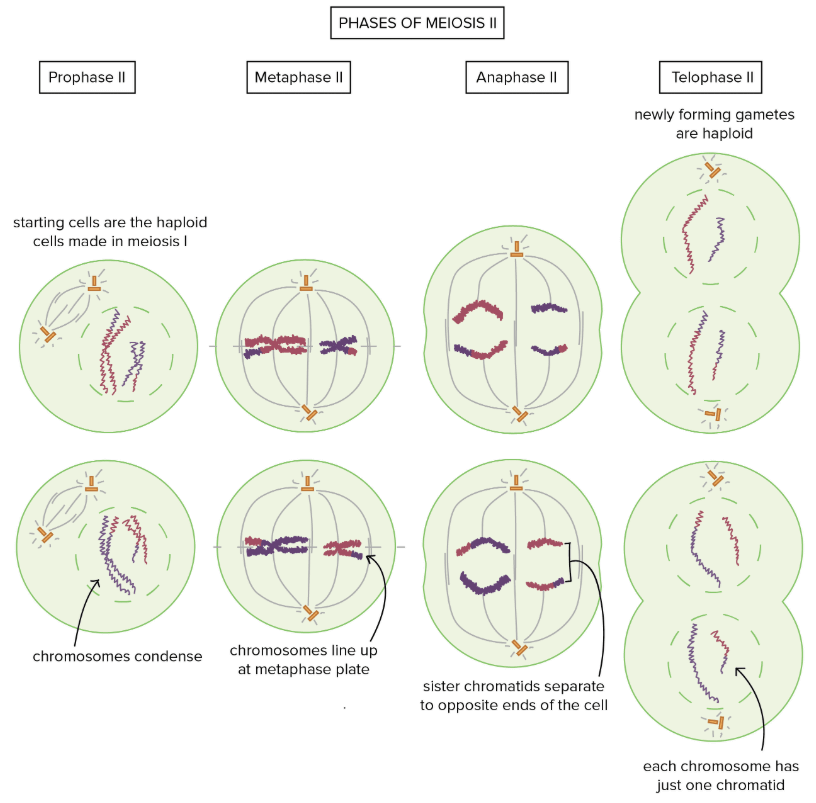
Prophase II
- Chromosomes 開始 condense
- Nuclear envelope 開始分解消失
- 兩個 Centrosomes 移到兩端,而 spindle 也隨之出現在中間
- Spindle microtubules 準備來抓取 chromosomes
Metaphase II
- Microtubules 從兩邊各自把 chromosome 的 sister chromatids 拉到中間
- Chromosomes 在 metaphase plate 排列整齊
Anaphase II
- Sister chromatids 被 microtubules 拉開來到兩端
Telophase II
- Cytokinesis 開始作用,随著 chromosomes 拆成兩個細胞
- Nuclear membranes 開始形成
- Chromosomes 開始 condense
最終產生了 4 個 haploid cells
- 每個 cell 的 chromosome 都是 1 個 chromatid
- 對人類來說,每個 cell 稱為 sperm 或 egg cell
How meiosis "mixes and matches" genes
Meiosis 產生的每個 haploid cell 都不是一樣的 (non-identical)
- 每個 gamete 都有唯一的 genetic material "sample"
- 研究發現,就算一開始的 somatic cell 只有 4 個 chromosomes
- 還是能產生非常多的 gamete types
- 會讓接下來的 meiosis 產生更多隨機性的原因有兩個
- Crossing over
- Homologues 互相交換 genetic material 的部分有時是隨機的
- Random orientation of homologue pairs
- Homologue paris 的方向也是隨機的
- Crossing over
對人類來說,總共有 8 million 種可能的 gamete types,加上每個人的獨特性,可以繁殖的可能性是無限
Cell cycle checkpoints
細胞在分裂的每個過程不一定是直接進到下一步,而是會根據各種因素而有 regulation
- Checkpoint 是 eukaryotic cell 分析內外環境"決定"是否繼續分裂的階段
- 最重要的 checkpoints 有三個
- G1 checkpoint (在 G1/S 中間)
- G2 checkpoint (在 G2/M 中間)
- spindle checkpoint (在 metaphase 和 anaphase 中間)
- 最重要的 checkpoints 有三個
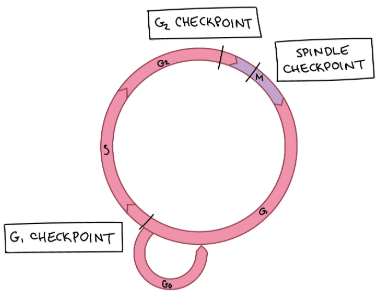
The G1 checkpoint
G1 checkpoint 是掌握細胞要不要分裂的關鍵
- 如果 G1 checkpoint 通過,進入到 S phase
- 那就是不可逆轉,要繼續進行下去到分裂完成
- 除非遇到不可預期的狀況發生 (DNA damage, replication error)
- 那就是不可逆轉,要繼續進行下去到分裂完成
G1 checkpoint 觀察的點為
- Size
- 細胞大小足以分裂嗎
- Nutrients
- 有足夠能量分裂或回復嗎
- Molecular signals
- 有收到任何鄰居的 positive cues 嗎 (e.g., growth factor)
- DNA integrity
- DNA 有損傷嗎
根據不同的細胞其實也會觀察不同事物
- 有的細胞需觀察 mechanical cues
- 例如有無附在 extracellular matrix 方便分裂
如果細胞沒辦法通過 G1 checkpoint,會進入到 G0 phase,等待因素達成 (或永遠待在 G0)
The G2 checkpoint
在進入 M phase 之前,會在 G2 checkpoint 扎實檢查 DNA 是否完整無誤,所以觀察的點為
- DNA integrity
- DNA 有損傷嗎
- DNA replication
- DNA 在 S phase 有被完整複製嗎
如果有問題,整個 cell cycle 會被停止,直到修復 DNA 或是完成 DNA 複製
- 如果傷害無法補救,細胞會自我毀滅
- 透過 apoptosis 或是 programmed cell death
- 避免將受損 DNA 傳給子女,防止 cancer 發生
The spindle checkpoint
在 M phase (mitosis) 會有一個 spindle checkpoint
- Spindle checkpoint 發生在 metaphase 進入 anaphase 之間
- 查看 sister chromatids 有沒有正確依附在 spindle microtubules 上 (metaphase plate)
- 因為 anaphase 將是不可逆的步驟,一定要讓 chromosomes 處於正確位置才行
Spindle checkpoint 不是以 scan metaphase plate 來檢查
- Spindle checkpoint 將尋找有無 chromosomes 迷路 (e.g., 在 cytoplasm)
- 如果有就會暫停 mitosis
- 給予時間將 chromosomes 移到正確位置
Cell cycle regulators
Checkpoint 會決定是否繼續分裂,主要透過改變 cell cycle regulators 的活動
- 這些 cell cycle regulators 用於非常多重要的活動
- DNA replication
- chromosome seperation
- trigger the onset of the next phase (e.g., G1 to S)
這邊來介紹幾個重要的 core cell cycle regulators
- Cyclins (protein)
- Cdks (enzyme)
- APC/C (enzyme complex)
Cyclins
Cyclins 都是一組一組 proteins,可以分成四種型態
- G1 cyclins
- G1/S cyclins
- S cyclins
- M cyclins
從名字可以看出,每種 cyclins 負責不同 phase 的活動
- 例如 M cyclin 主要負責 M phase 中的活動
- nuclear envelope breakdown
- chromosome condensation
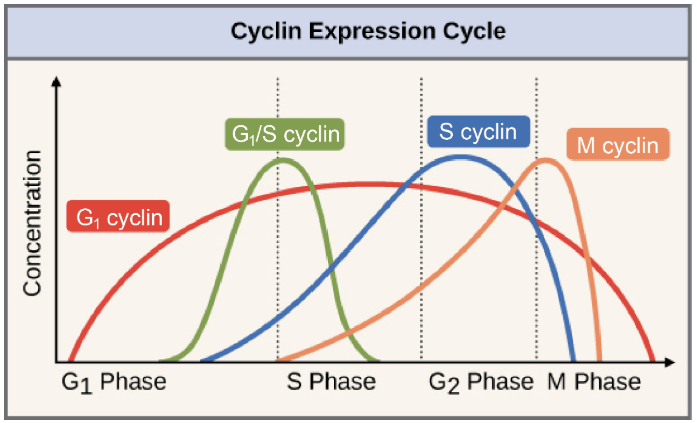
- 一般的 Cyclins 會在各種 phase 幫忙簡單 low level 的任務
- 只有 G1 cyclins 不同,整個 cycle 幾乎都需要他的幫忙
Cdks (Cyclin-dependent kinases)
Cyclins 為了驅使該 phase 的活動進行,需要 activate/inactivate 一些 target proteins
- Cyclins 會和夥伴 Cdks (cyclin-dependent kinases) 一起活動
- 單獨的 Cdk 是 inactive 的
- 跟 cyclins 結合後才是 active 的
- Active 的 Cdks 是 functional enzyme,可以修改 target proteins
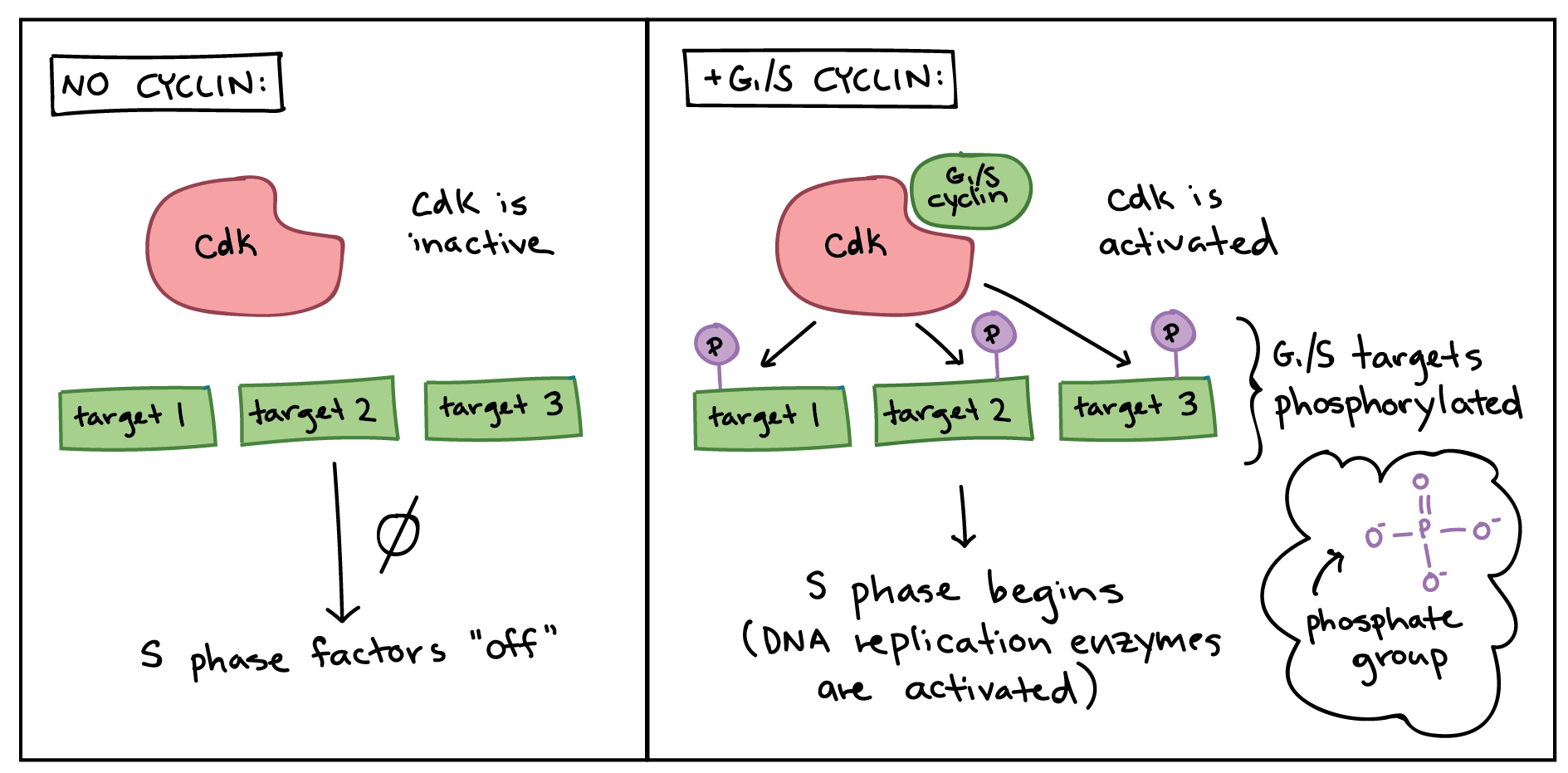
- Cdks 是 kinases (phosphorylate target proteins 的 enzyme)
- Phosphate group 就像 switch 一樣
- 能夠 Activate 或 inactivate 這些 target protein
- Phosphate group 就像 switch 一樣
當 cyclin 接觸到 Cdk 時,會發生兩件大事
- Activate Cdk 使他成為 kinase
- 將 Cdk 引導到由該 cyclin 負責的 phase 時的特定 target proteins
- 例如 G1/S cyclins 傳送 Cdks 到 S phase targets
- 幫助 DNA replication
- 或是 M cyclins 傳送 Cdks 到 M phase targets
- 幫助 breakdown nuclear membrane
- 例如 G1/S cyclins 傳送 Cdks 到 S phase targets
APC/C (The anaphase-promoting complex/cyclosome)
Anaphase-promoting complex/cyclosome 是 protein complex
- APC/C 會在 anaphase 造成 M cyclins 被破壞
- 促使新的 cell 結束 mitosis 重新進入 G1
- APC/C 也會造成 sister chromatids 中間的 protein 被破壞
- 讓 sister chromatids 能夠進一步在 anaphase 被推向兩端
APC/C 雖然和 Cdks 一樣為 enzyme 但功能不同
- APC/C 會發送 ubiquitin (Ub) 這個標籤給 target proteins
- 收到的 protein 會被送到細胞中的 proteasome (回收筒)
- 例如 M cyclins 就會收到 Ub 然後送到 proteasome 解決
- 收到的 protein 會被送到細胞中的 proteasome (回收筒)
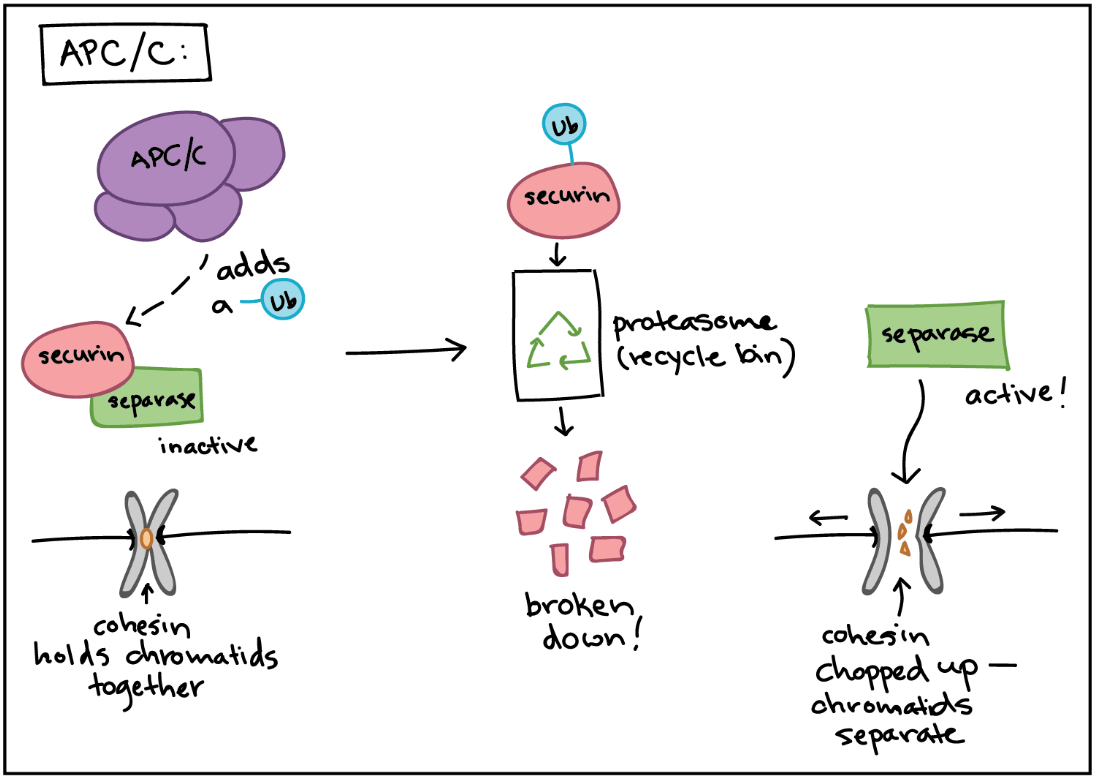
上圖是 APC/C 幫助 sister chromatids 分開的過程
- APC/C 在 metaphase 收到 signals
- 進行一連串活動來破壞 cohesin (glue of sister chromatids)
- APC/C 將 ubiquitin tag 貼到 securin (protein)
- Securin 通常會和 separase (protein) 在一起
- 沒有了 securin
- Separase 就會去拆掉 cohesin 順利讓 sister chromatids 分開
- APC/C 將 ubiquitin tag 貼到 securin (protein)
Checkpoints and regulators
- 以上這些 cell cycle regulators 要因為細胞內外的信號才會活動
- Positive cues
- growth factors: 增加 Cdks, cyclins 的活動
- Negative cues
- DNA damage: 減少或停止整個活動
- Positive cues
以下展示一個 DNA damage 造成 cycle 停止於 G1 phase 的例子
- 當人類照射到 UV rays 時 DNA 可能會受到傷害
- 細胞要修復或避免將損壞的 DNA 複製下去
- 有一個關鍵的 protein 叫做 p53 會幫忙這些事情
- p53 又稱作 "the guardian of the genome" 是一個 tumor suppressor
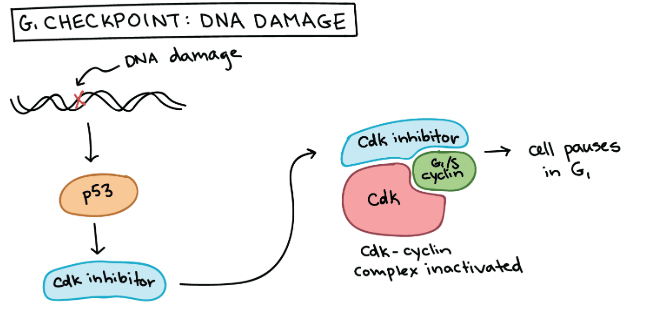
- p53 在細胞分裂中幫助處理 DNA damage 可以分成三大角色
- 將 cycle 停止在 G1 checkpoint
- 利用 Cdk inhibitor (CKI) proteins
- CKI 會結合到 Cdk-cyclin complexes 然後停住他們的活動
- Activate DNA repair enzymes
- 如果沒救了,就啟動 programmed cell death
- 將 cycle 停止在 G1 checkpoint
Cell cycle regulators and cancer
不同的基因突變會造成不同的癌症,但 regulators 會造成癌症的突變大致分為兩類
- Positive regulators overactivate (become oncogenic)
- Negative regulators inactivate (e.g., tumor suppressors)
Oncogenes
- 促使 regulators overactive 的基因稱為 oncogenes
- 還沒突變的 oncogenes 稱為 proto-oncogenes
讓 proto-oncogenes 變成 oncogenes 的方法有很多
- 改變 protein 的 amino acid sequence
- 讓 protein 形狀改變,變成永遠為 "on" 的狀態
- Amplification
- 給細胞過多的 gene copies,建造過多的 proteins
- DNA repair 發生錯誤
- 使 proto-oncogene 和其他不同 gene 結合,產生 "combo" protein (會有不正常的活動)
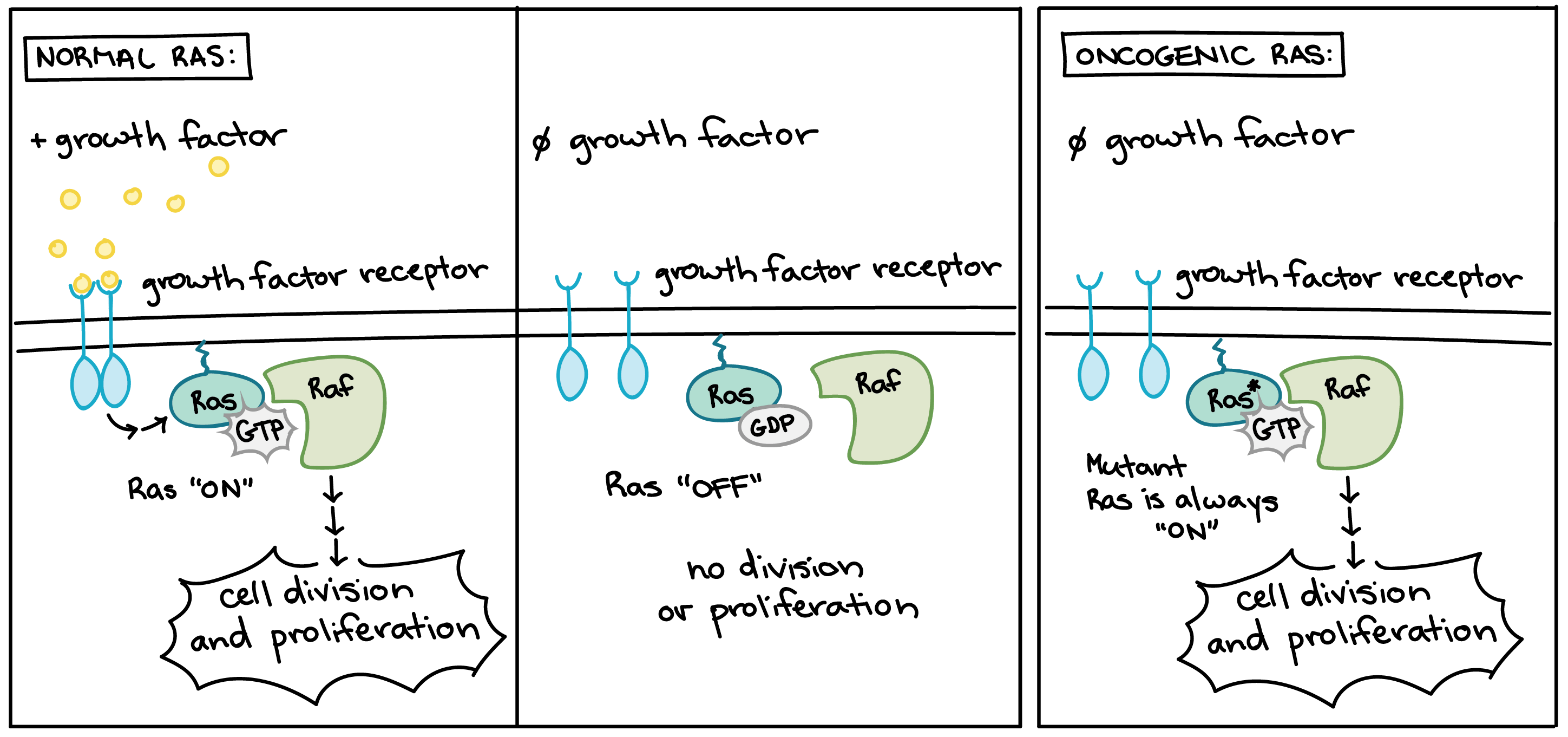
很多 protein 在傳遞的 growth factor signals 都是來自 proto-oncogenes 來 encode
- 當基因變異,一些 proteins 不管有沒有 growth factor 都將 signals 傳出
- 就會變成上圖的樣子
- 由 proto-oncogenes 所 encode 的兩個 protein 發生異常
- Ras protein (growth factor receptor)
- Raf signaling enzyme
這些 overactive 的 proteins 可以常見於 cancer cells
- Oncogenic Ras mutations 可以在 90% 的 pancreatic cancers 看到
- Ras 是 G protein,相當於 active/inactive 的開關
- Cancer-causing mutation 會讓這個開關失效
- 變得很難或是無法 inactive,卡在 active 的狀態
Tumor suppressors
- 幫助從 DNA damage 暫停 cell cycle 運作的是 tumor suppressors
- 其中某個重要的是 tumor protein p53
- 基因突變可能造成 p53 無法進行他的工作
- 可能由其他的方法來解決,例如增加 p53 的回收
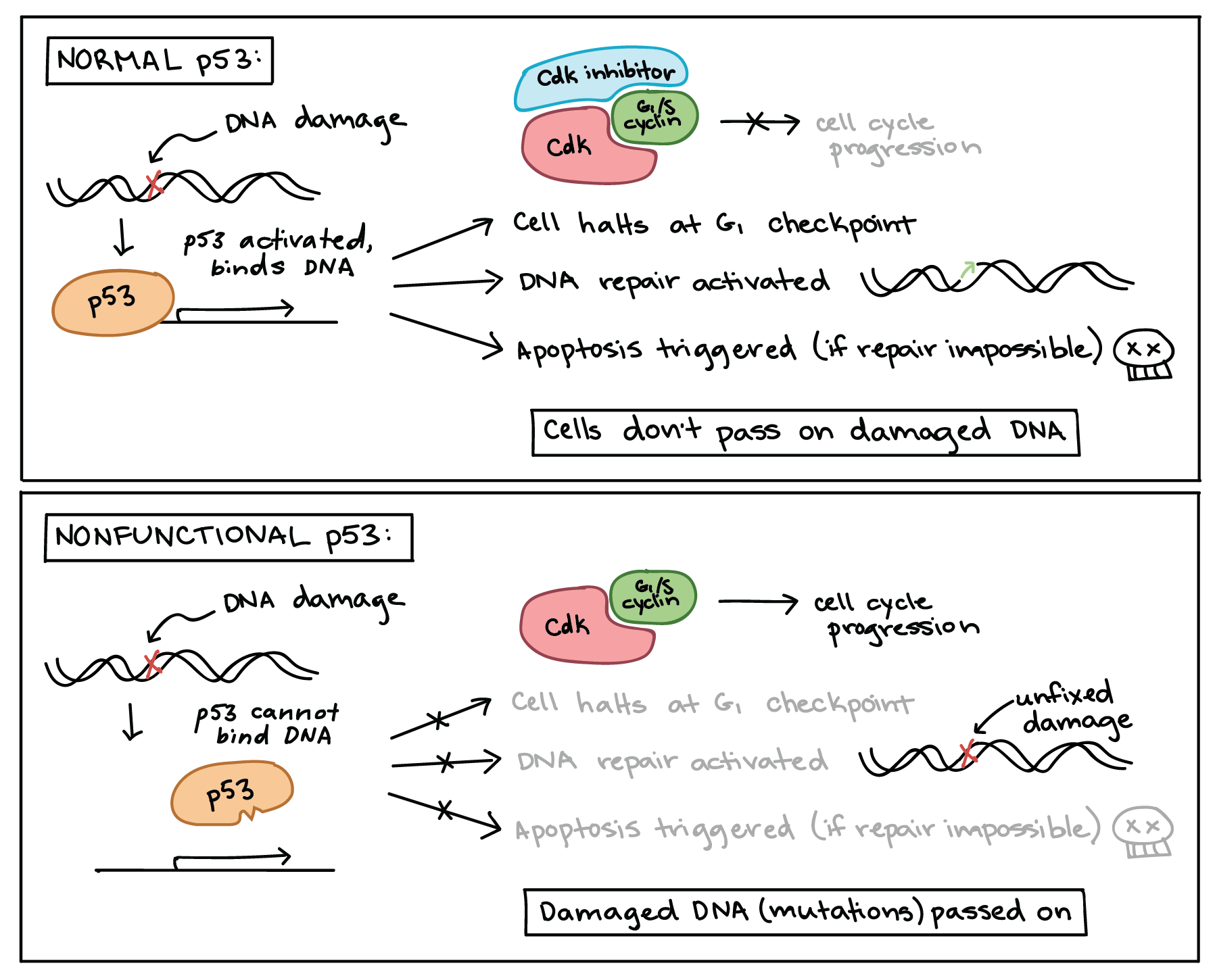
Apoptosis
細胞死亡可能是不好的事情,但只要是在良好的控制下,對生物是很有幫助的
- Apoptosis 就是良好控制下的"細胞自殺"
- 是 programmed cell death 的一種
- 他雖然讓細胞死亡,但卻讓整個生物體受益
- 例如 finger development, eliminate potential cancer cells
其實幫助我們手指生長的細胞,早在很久以前就已經死亡了。
這是為了讓手指能夠順利長成現在的樣子,如果細胞還在,那我們手就會變成像蹼狀一樣的手 !
Apoptosis vs. necrosis
細胞主要有兩種死法,分別是 apoptosis 和 necrosis
- 被不好的東西搞死的叫做 necrosis
- 例如 toxic chemicals 或 physical injury
- Messy
- 會造成 immune response 或 inflammation
- 被觸發的 programmed cell death 有很多種
- 最常見的就是 apoptosis
- Tidy
- 將不要的細胞切成一份一份,讓細胞能夠被 recycle
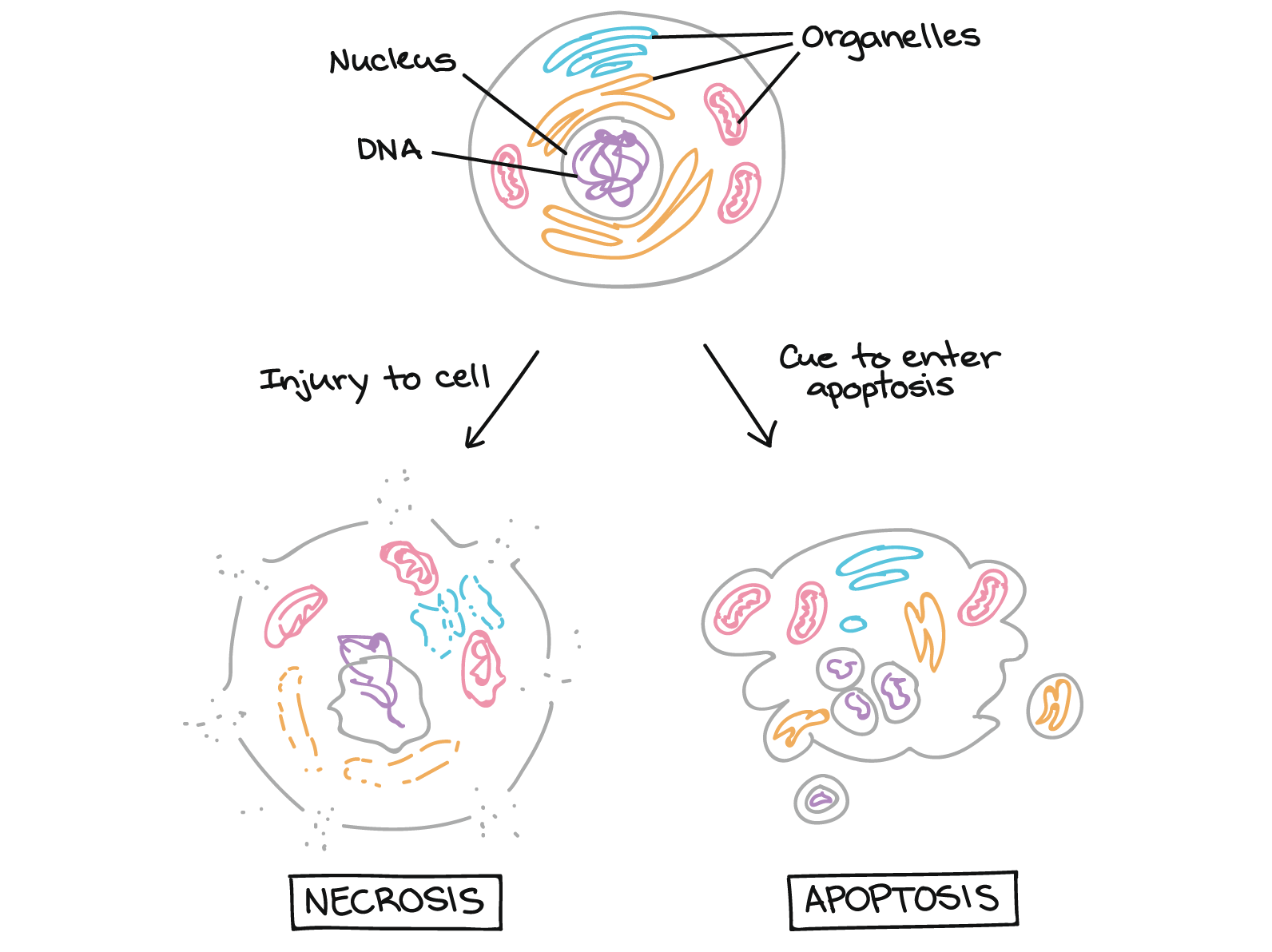
Necrosis (the messy way)
- 通常發生於細胞受到外部攻擊 (injury, toxicity)
- 因為 membrane 無法再控制進出,造成膨脹
- 爆炸,細胞噴發所有內容物
- 在充斥 dead cell 的 tissue 周圍造成 inflammation
Apoptosis (the tidy way)
細胞有秩序的死亡,縮成像泡泡一樣的 blebs
- DNA 被切成很多碎片
- 一些 organelles (e.g., endoplasmic reticulum) 也分解成碎片
- 整個細胞變成一個個由 membrane 完整包裝的 chunks
變成 chunks 之後
- 這些 chunks 會釋放 signals 來吸引 debris-eating (phagocytic) immune cells
- 例如 macrophages
- 一些會將 phosphatidylserine (lipid molecule) 放到 membrane 表面
- Phosphatidylserine 通常隱藏在 membrane 裡面
- 這會吸引 phagocytes 來結合然後被吃掉
- 這些 chunks 會釋放 signals 來吸引 debris-eating (phagocytic) immune cells
Why apoptosis
Apoptosis 和 DNA 複製或是分解養分一樣,都是細胞天生具有的能力
- Apoptosis 動機是移除不該繼續存在於該 organism 的細胞
- 刪除一些影響發展的細胞
- 例如發展手指的時候,避免讓手長成一整塊 tissue
- 移除異常、可能傷害其他 organism 的細胞
- 例如 viral infection, DNA damage
- 保持身體平衡而淘汰細胞
- 例如為了給新細胞位置,或移除只負責短暫工作的細胞
- 幫助免疫系統運作
- 移除為了對付 pathogen 而大量產生的 immune cells
- 刪除一些影響發展的細胞